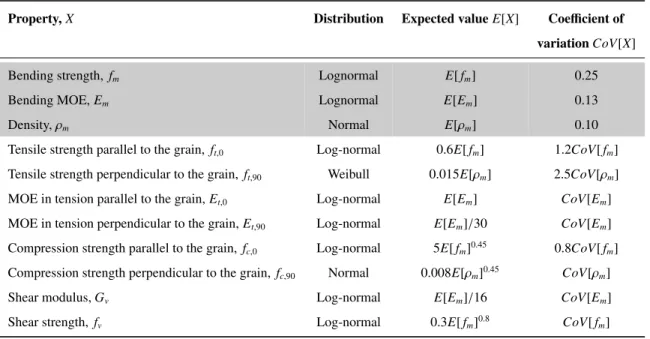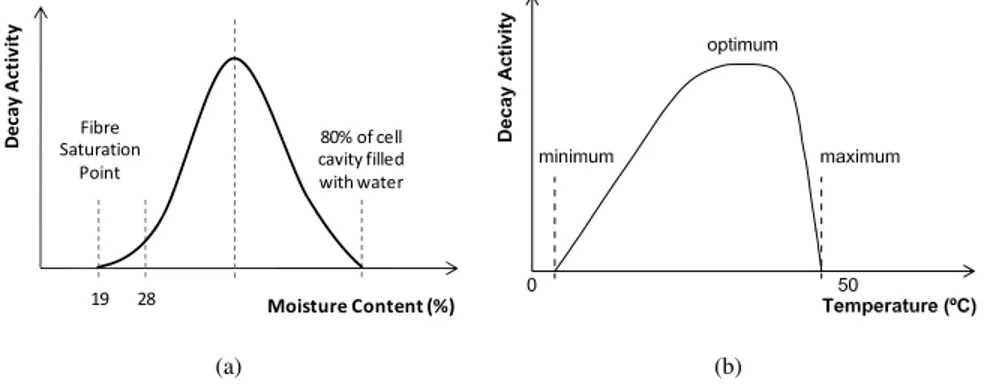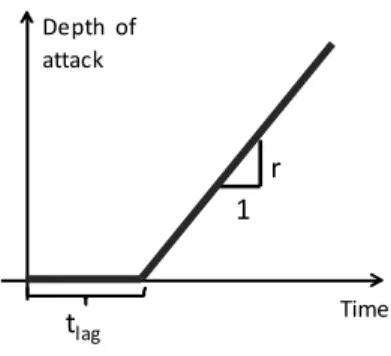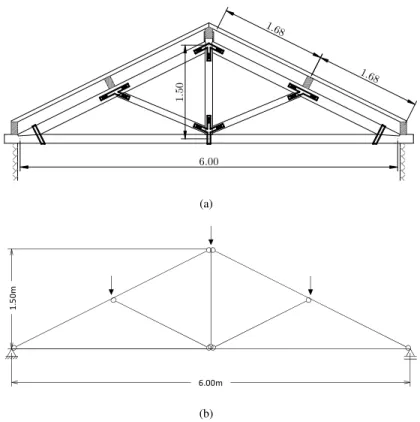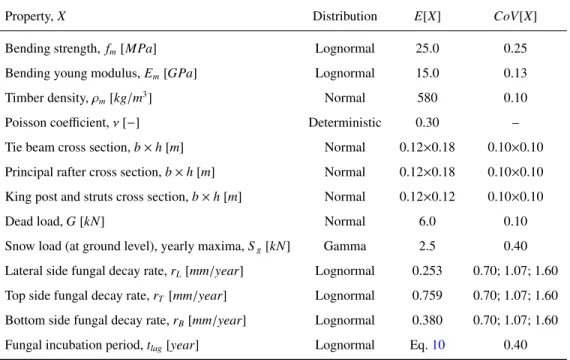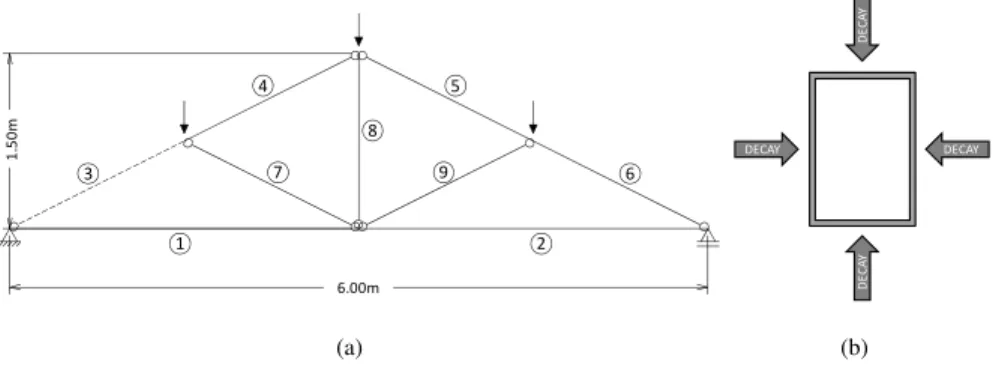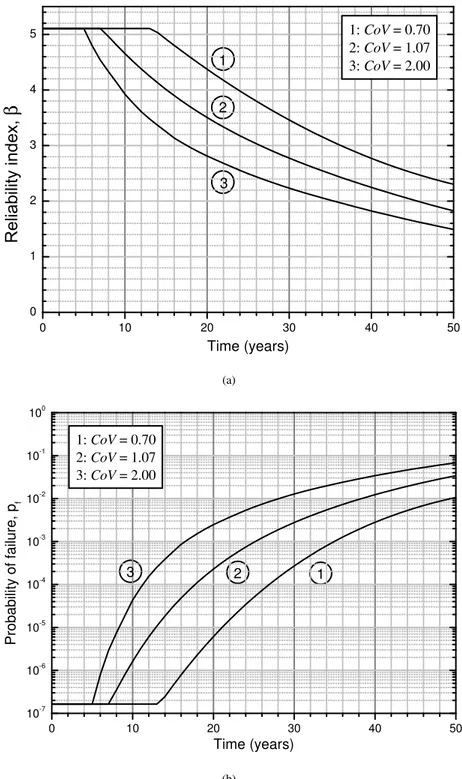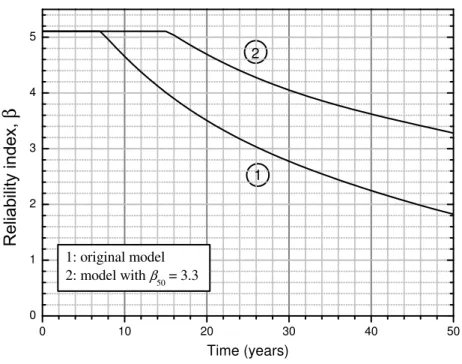Reliability analysis of a timber truss system subjected to
decay
Ricardo D. Britesa, Lu´ıs C. Nevesb, J. Saporiti Machadoc, Paulo B. Lourenc¸oa,∗, H´elder S. Sousaa
aUniversidade do Minho, ISISE, Dept. of Civil Engineering, Azur´em P-4800-058 Guimar˜aes, PORTUGAL bUNIC, Universidade Nova de Lisboa, Dept. of Civil Engineering, Quinta da Torre, 2829-516 Monte da
Caparica, PORTUGAL
cLaborat´orio Nacional de Engenharia Civil, N´ucleo de Estruturas de Madeira, Av. Do Brasil, 101
1700-066 Lisboa, PORTUGAL
Abstract
Assessing the safety of existing timber structures is of paramount importance for tak-ing reliable decisions on repair actions and their extent. The results obtained through semi-probabilistic methods are unrealistic, as the partial safety factors present in codes are calibrated considering the uncertainty exhibited by new structures. In order to over-come these limitations, and also to include the effects of decay in the safety analysis, probabilistic methods, based on Monte-Carlo simulation are applied here to assess the safety of existing timber structures. In particular, the impact of decay on structural safety is analyzed and discussed using a simple structural model, similar to that used for current semi-probabilistic analysis.
Keywords: structural reliability, timber structures, biological deterioration, model, fungi, damage
1. Introduction
The safety evaluation of an existing structure is a key task if a decision to maintain it in service is to be taken. This task allows also the definition and prescription of conservation and strengthening measures, if needed. The process requires knowledge on the geometric and mechanical properties of timber members, as well as on the loads
that the structure was and will be subjected to. Although the geometrical properties can be gathered by direct in situ measurements, strength capacity and stiffness are more difficult to obtain.
Moreover, in old structures, the mechanical properties of timber are affected, not only by the duration of load and moisture content, but also by biological activity, which is common in elements in direct contact with masonry walls subjected to water infiltra-tion. Due to the influence of different issues not considered in the original design, like ageing, load history, decay, etc., the usual procedure of design for new timber struc-tures cannot be directly applied in the safety evaluation of ancient strucstruc-tures. The strict application of design codes to existing structures often leads to an inadequate safety evaluation and, often, unnecessary structural replacement. Most advanced safety eval-uation models for timber structures, like the probabilistic safety evaleval-uation, are seldom used due the difficulty in modeling important characteristics of wood, such as duration of load and influence of defects (knots, etc.). Recent publications and works in these ar-eas have provided information that helps overcoming these issues (K¨ohler et al.,2007). The influence of biological decay in structural safety can be critical to choose if, where and when a repair is needed, but there is no practical means to take biological decay into account in a semi-probabilistic analysis, since existing models relate the loss of strength with the loss of weight. A more consistent approach, relating the time of attack with the loss of mechanical properties is required for safety analysis purposes. The assumption made in the present paper is that when decay is present in a structural timber member, a reduced cross-section can be obtained. The same concept is applied to structural fire design of timber structures, in which the charred superficial layer is removed and the remaining cross-section is assumed to retain its full strength capacity. Here, the effect of initial fire degradation (with alteration of wood chemical properties and some cell wall damage) is compared with incipient fungi degradation.
Timber decay also has significant impact on the performance of timber joints. How-ever, this aspect is not considered in the present paper, as no data on this impact, for the timber joints commonly used in historical structures in Europe, exists.
structures became affordable. The development of structural codes with an explicit probabilistic approach, namely the Probabilistic Model Code (PMC) (JCSS,2001) has allowed the spread of reliability-based methods in the safety evaluation of common structures.
Probabilistic methods for safety analysis are often based in the evaluation of a limit state function, which, in case of analysis of material degradation leading to failure of performance, requires an understanding of the structure environment, the transfer mechanism, the environmental action and leading to action effects that may result in failure. In this scope, the International StandardISO 13823(2008) specifies general principles and recommends procedures for the verification of the durability of struc-tures subject to known or foreseeable environmental actions, including mechanical ac-tions, causing material degradation performance reduction. In this case, for material deterioration resulting in failure due to loss of resistance, the ultimate limit state is defined when the resistance of the component or structure becomes equal to or less than the internal force. Therefore, structures and their components shall be designed, inspected, maintained and repaired in such a way that, under foreseeable environmen-tal conditions, they maintain their required performance during their design lives with sufficient reliability for the safety and comfort of users and the intended use of the structure, thus providing that the service life of the structure meets or exceeds the de-sign life.
2. Simplified probabilistic modelling: the Monte Carlo method
Probabilistic methods of safety analysis allow explicit consideration of uncertainty in the structural model, even if more computational power and a deeper knowledge of the modelled variables are needed. The Monte Carlo method, used hereafter, is a sim-ple probabilistic method that evaluates the Limit State Function (LSF) in a predefined number of points randomly chosen. Basically, this is achieved by simulating a large number of events and evaluating the structural response for each one of them, being the obtained response statistically treated.
pure simulation, which can be synthesized in the following steps:
1. Definition of the problem in terms of random variables;
2. Definition of the parameters of random variables (distribution, parameters and correlation among variables);
3. Simulation ofNsimvectors of random variables;
4. “Deterministic” structural evaluation of each one of theNsimsamples;
5. DefiningNf as the number of simulations where the limit state function is
vio-lated, the probability of failurepf can be estimated bypf:
pf ≃pf = Nf
Nsim
(1)
6. Definition of the accuracy and efficiency of the simulation, by means of varying
Nsimand evaluating how much it affects the results.
The number of simulations needed to keep the error below a predefined value is strongly dependent on the probability of failure. A practical way of estimating the number of simulations needed for values of probability of failure aboutpf =10−nis
to make at least 10n+2 simulations. Shooman(1968) proposed the expression for the maximum error in the estimate ofpf for a 95% confidence interval, given by:
error=2 s
1−pf Nsim·pf
(2)
3. Probabilistic models for timber mechanical properties
The adopted probabilistic models for the mechanical properties of timber are based on the theory described in PMC (K¨ohler et al.,2007,JCSS,2001), which requires three
reference variables, namely bending modulus of elasticity (MOE), bending strength (fm) and density (ρ). All the other relevant mechanical properties are established by
empirical relationships with the reference variables. The proposed relations and statis-tical distributions are presented in Table1.
Table 1: Density probability function of timber mechanical properties, defined as a function of thereference variables(in grey rows), according toJCSS(2001)
Property,X Distribution Expected valueE[X] Coefficient of
variationCoV[X]
Bending strength,fm Lognormal E[fm] 0.25
Bending MOE,Em Lognormal E[Em] 0.13
Density,ρm Normal E[ρm] 0.10
Tensile strength parallel to the grain,ft,0 Log-normal 0.6E[fm] 1.2CoV[fm]
Tensile strength perpendicular to the grain,ft,90 Weibull 0.015E[ρm] 2.5CoV[ρm]
MOE in tension parallel to the grain,Et,0 Log-normal E[Em] CoV[Em]
MOE in tension perpendicular to the grain,Et,90 Log-normal E[Em]/30 CoV[Em]
Compression strength parallel to the grain,fc,0 Log-normal 5E[fm]0.45 0.8CoV[fm]
Compression strength perpendicular to the grain,fc,90 Normal 0.008E[ρm]0.45 CoV[ρm]
Shear modulus,Gv Log-normal E[Em]/16 CoV[Em]
Shear strength,fv Log-normal 0.3E[fm]0.8 CoV[fm]
Table 2: Correlation matrix for material properties, according toJCSS(2001) fm Em ρm ft,0 ft,90 Et,0 Et,90 fc,0 fc,90 Gv fv
fm 1.0 0.8 0.6 0.8 0.4 0.6 0.6 0.8 0.6 0.4 0.4
Em 1.0 0.6 0.6 0.4 0.8 0.4 0.6 0.4 0.6 0.4
ρm 1.0 0.4 0.4 0.6 0.6 0.8 0.8 0.6 0.6
ft,0 1.0 0.2 0.8 0.2 0.5 0.4 0.4 0.6
ft,90 1.0 0.4 0.4 0.2 0.4 0.4 0.6
Et,0 1.0 0.4 0.4 0.4 0.6 0.4
Et,90 1.0 0.6 0.2 0.6 0.6
fc,0 1.0 0.6 0.4 0.4
fc,90 Symmetric 1.0 0.4 0.4
Gv 1.0 0.6
4. Probabilistic models for loads
Loads can be distinguished between dead loads and live loads. The first group in-cludes loads that are always present in the structure and that have values approximately constant over time. These actions are the most relevant for long term effects (creep), being associated with the weight of the structure and the supported elements (tiles, ceilings, etc.). Live loads are stochastic processes in time.
The probabilistic modelling of dead loads can be easily achieved by considering the randomness of cross-sections and density of the materials. Live loads are more complex to model and only simplified extreme value distributions are considered here. It is noted that snow and wind loads are often critical for the design of timber roofs, while imposed loads are often critical for the design of timber floors.
5. Limit state functions and reference values for the reliability index
Limit State Functions (LSF) are used to determine if a given element/structure con-tinues to fulfil its function as desired. These functions should be defined in such way that they assume negative values if violated. The simplest way of expressing limit state functions is:
G(x)=R(x)−S(x) or G(x)=1−S(x)
R(x) (3)
Here, R(x) represents the mechanical resistant properties andS(x) the effects of applied actions. The safety check of timber structures for the Ultimate Limit Sates (ULS) requires that several types of internal forces are evaluated in the same function. For these cases, a more complex formulation for the limit state function is required.
K¨ohler et al.(2007) suggest the adjustment of the Eurocode 5 (EN 1995:1-1,2004) formulation by removing the partial safety factorγMof this formulation and making
the equation negative if the safety check is not fulfilled. As an example, it is possi-ble to considerEN 1995:1-1 (2004), for verification of columns subjected to either compression or combined compression and bending4. The Eurocode 5 formulation is:
σc,0,d kc,yfc,0,d
+σm,y,d
fm,y,d
+km
σm,z,d fm,z,d
Here,σc,0,d,σm,y,dandσm,z,dare the design compressive stress along the grain,
de-sign bending stress about the principal y-axis and dede-sign bending stress about the prin-cipal z-axis (respectively); fc,0,d, fm,y,d and fm,z,d are the design compressive strength
along the grain, design bending strength about the principal y-axis and design bending strength about the principal z-axis (respectively);kc,yis the instability factor andkma
factor that considers the re-distribution of bending stresses in a cross-section (EN 1995:1-1,2004). In the LSF formulation, this equation should be expressed as:
G(x)=1− "
σc,0 kc,yfc,0
+σm,y
fm,y
+km
σm,z fm,z
#
(5)
The absence of thed in the subscript of variables stresses that this verification is now made with the simulated values, instead of design values. The safety condition of the structure is now established by limiting the probability of failure to a given value.
Another common way of expressing the same result is by using the reliability index β, which can be calculated directly from the probability of failure byβ =−Φ−1(pf),
whereΦ−1denotes the inverse of the standard normal distribution. Target values for this parameter are established as a function of the importance of the building and the cost to upgrade its safety. Hence, critical structures, like hospitals and bridges, must exhibit a higher reliability index than ordinary structures, which implies that the probability of failure should be (much) smaller. The values suggested inJCSS(2001) are given in Table3. In new ordinary structures a target reliability index ofβ= 4.2 is usually used, but in existing structures the cost of structural interventions is generally high and a lower target reliability index ofβ =3.3 is used instead. This is the value assumed hereafter.
6. Probabilistic models for fungal decay in timber structures
Degradation of timber structures often occurs with the decay of elements in direct contact with masonry walls, where the high moisture content and mild temperatures provides an optimal media for the development of fungi.
Table 3: Target reliability indexesβsuggested byJCSS(2001), established as a function of consequences of collapse and difficulty to upgrade the safety level
Cost for upgrading Collapse consequences
the safety level Low Medium High
High β=3.1 β=3.3 β=3.7
Average β=3.7 β=4.2 β=4.4
Low β=4.2 β=4.4 β=4.7
Temperatures in the range 5oC – 30oC are adequate for fungi growth, being fungi latent below 5oC and killed above 65oC. In terms of moisture content, values below the fibre saturation point or above 80% of cell cavity filled with water are inadequate. Idealised relations between temperature and rate of growth, and moisture content and rate of growth, are given in Figure1.
Dec
a
y
A
c
ti
vi
ty
Moisture Content (%)
80% of cell cavity filled with water Fibre
Saturation Point
19 28
(a) (b)
Figure 1: Theoretical fungal growth as a function of (a) moisture content and (b) temperature, according
toZabel and Morrell(1992)
durability and structural conditions of the timber element, according to Equation6:
r=k0·kclimate (6)
The coefficientk0is given by the consideration of several parameters, such askwood
(wood parameter),kt (thickness parameter), kw(width parameter),kn (connector
pa-rameter),kg(geometry parameter) andkp(paint parameter), according to Equation7:
k0=kwood·kt·kw·kn·kg·kp (7)
The paramenterkwooddepends on the timber durability class as defined in AS
5604-2005 (AS 5604-2005,2005) andkclimate depends on climate factors. Thekclimate is a
parameter that considers the effect of climate conditions with respect to the annual time of rainfall,train, in hours. Thekclimateis given according to Equation8, and a correlation
coefficient betweenkclimateandtrainof 0.44,is considered (Wang and Leicester,2008).
According to the same authors, regarding the influence of temperature on decay rate, no noticeable correlation was found.
kclimate=0.03·t0rain.5 (8)
Sincekwooddepends on the durability of the wood species with respect to the
patho-logical agents andkclimatedepends on the vulnerability to fungal decay due to climatic
variation in a given location, these parameters were considered uncorrelated. Lognor-mal distributions are introduced according to the data from field tests in (Wang and Leicester,2008). The parameterskwoodandkclimatehave been calibrated for Australian
species and climate, with the values presented in Table4for above-ground timber el-ements (Leicester et al.,2009). Here, four climatic hazard zones are considered (A to D), where hazard zone A corresponds to the climate with lower annual time of rainfall and hazard zone to the climate with higher annual time of rainfall (see Table4 and Table5).
The thickness parameterktand the width parameterkwtake into account the effects
element is in contact with other elements. The parameterkttakes values between 0.5
and 1 for a thickness of the timber element between 10 and 20 mm, respectively. The parameterkwtakes values between 1 and 2 for a width of the timber element between
50 and 200 mm, respectively. Forkt andkw, intermediate values are calculated by
linear interpolation. The connector parameterkntakes into consideration the effect of
the presence of a connector on the decay surface, taking a value of 1 when there is no connector and a value of 2 when a connector is present. The geometry parameterkg
is calculated by the multiplication of a contact factorkg1 that depends on the type of contact between members (flat, embedded or non-contact) and a position factorkg2that depends on the orientation of the decay face. The paint parameterkptakes into account
the effect of paint, having values of 1 for unpainted timber and values between 1.3 and 3.5 (depending on the timber class) for painted timber.
Table 4: Suggested parameters forkclimatedistribution, according toLeicester et al.(2009)
Zone Mean(kclimate)
A 0.40
B 0.50
C 0.65
D 0.75
Table 5: Suggested parameters forkwooddistribution, according toLeicester et al.(2009)
Durability class
Mean(kwood)
outer heartwood inner heartwood untreated sapwood treated sapwood
1 0.50 1.00 6.52 0.25
2 0.65 1.30 6.52 0.25
3 1.15 2.30 6.52 0.25
4 2.20 4.40 6.52 0.25
E[r] = E[k0]·E[kclimate] (9)
Another parameter necessary for the definition of decay is the time of incubation
tlag, which is the time between the installation of the timber element and the initiation
of performance loss due to decay. This parameter,tlag (years) can be estimated as a
function of the decay rater(mm/year) according to experimental data (Leicester et al., 2009):
tlag =8.5r−0.85 (10)
A lognormal distribution with an expected value given by Equation10can be used.
Depth of attack
r 1
tlag Time
Figure 2: Numerical modelling of decay depth as a function of time: theoretical modelLeicester et al.(2009)
Numerically, the depth of attackd(mm) over time can be modelled according to Equation11:
d(t)=
0 t≤tlag
r·(t−tlag) t>tlag
(11)
7. Experimental characterization of an European wood specie subjected to decay
For calibration of the previous model to the Portuguese conditions, a series of decay tests using Maritime Pine timber (PinuspinasterAit.) subjected to a brown rot fungus is under study in the Portuguese National Laboratory of Civil Engineering (LNEC), for different exposure periods and cross sections (Brites,2011). Decay stages (from incip-ient decay to advanced decay), defined to each sample attending to visual inspection, and the time necessary to achieve each stage are recorded. Decay is being induced by placing the specimens in contact with a brown rot fungus, namelyConiophoraputeana
(Shumach.) P. Karst., obtained in a laboratory growth culture. With an average period-icity of two months the specimens are being assessed visually and by their superficial hardness. The specimens were fully placed in contact with the laboratory culture and water was periodically added in order to obtain favorable conditions for fungal growth. After removal from the decay laboratory culture, the specimens’ moisture content was measured. The smaller specimens presented a mean moisture content of 52.7% while, for the medium size specimens, a mean moisture content of 26.44% was found. At this stage, only the results considering the reference stage and the incipient stage for small (20×40×120mm3) and medium size (30×90×180mm3) specimens are available, since the exposure time so far (four years) was not sufficient to reach more severe de-cay stages. For these specimens the exposure time that lead to the consideration of an incipient decay stage is shown in Table6, showing aCoVabove 40%.
Table 6: Statistic parameters for the exposure time needed to reach an incipient decay stage
Specimen µ[days] σ[days] CoV[%] Noof specimens
20×40×120 259 114 44.0 45
30×90×180 296 120 40.5 17
8. Influence of decay in timber connections
9. Probabilistic evaluation of a traditional roof truss
The methodology detailed above is now applied to a traditional roof truss, namely the 6.00mspan king post truss built in Maritime Pine wood shown in Figure3.
6.00
1.68
1.68
1.5
0
(a)
6.00m
1.
5
0m
(b)
Figure 3: Roof truss studied: (a) “real” structure; (b) adopted truss model
The adopted random variables are given in Table7, being the remaining mechan-ical properties established by the empirmechan-ical relations given in Table1, with the cor-relation matrix for mechanical properties defined in Table 2. The assumed cross-sections replicate usual conditions and dead loads are established according to Eu-rocode 1 (EN 1991:1-3,2003). The modification factor takes into account the duration of load effect and moisture content and its value is considered as constant and equal to
kmod=0.60, as described inEN 1995:1-1(2004).
recommended. A Gamma distribution was used for definition of the snow load (JCSS, 2001). Using the annual maximum values it is possible to define characteristic values of snow load with respect to a certain exceedance, directly associated to a certain mean recurrence interval. The characteristic value for snow load, in Eurocodes and National annexes, is the value corresponding to a probability of exceedance of 2% per year or a mean recurrence time of 50 years. The Gamma distribution is a two-parameter family of continuous probability distributions with a scale parameterθand a shape parameter
k. The two parameters for definition of the probability distribution may be found by:
θ=|(E·CoV)2/E| (12)
k=|E/θ| (13)
The mean value for snow load at ground level was established by the method pro-posed inEN 1991:1-3(2003). The snow shape coefficients (µ1,µ2) vary with the roof pitch angle, being considered asµ1 =0.8 andµ2 =1.6, assuming the larger value in the left side. The non-symmetric load distribution is more stringent than the symmetric load distribution, being the difference larger as decay increases.
The decay rate for the rafters was determined by Equation6, for a temperate climate (kclimate=0.50) and assuming that the timber used is outer heartwood with durability
class 3 (kwood=1.15). Considering the rafter cross section dimension, the effects of
drying restraints are given bykt=1 andkw=1.47. Since the value ofkgis dependent
of the orientation of the decay face, different values were obtained, namelykg =0.9
for the top face,kg=0.45 for the bottom face andkg=0.3 for the lateral faces. In all
faces a non-contact situation was assumed. Also it was considered that no connector is present (kn =1) and that the timber element is unpainted (kp=1). All the adopted
parameters and distributions are given in Table7.
frag-Table 7: Adopted distributions and parameters for the random variables of the problem
Property,X Distribution E[X] CoV[X]
Bending strength,fm[MPa] Lognormal 25.0 0.25
Bending young modulus,Em[GPa] Lognormal 15.0 0.13
Timber density,ρm[kg/m3] Normal 580 0.10
Poisson coefficient,ν[−] Deterministic 0.30 –
Tie beam cross section,b×h[m] Normal 0.12×0.18 0.10×0.10
Principal rafter cross section,b×h[m] Normal 0.12×0.18 0.10×0.10
King post and struts cross section,b×h[m] Normal 0.12×0.12 0.10×0.10
Dead load,G[kN] Normal 6.0 0.10
Snow load (at ground level), yearly maxima,Sg[kN] Gamma 2.5 0.40
Lateral side fungal decay rate,rL[mm/year] Lognormal 0.253 0.70; 1.07; 1.60
Top side fungal decay rate,rT[mm/year] Lognormal 0.759 0.70; 1.07; 1.60
Bottom side fungal decay rate,rB[mm/year] Lognormal 0.380 0.70; 1.07; 1.60
Fungal incubation period,tlag[year] Lognormal Eq.10 0.40
ile structural behaviour implies that the structure collapses when its first element col-lapses, which is generally true for simple roof trusses but false for complex structural solutions, as the latter can allow multipleload paths.
Properties of random variables (distributions, parameters)
Number of simulations to perform: Nsim
Structure to be studied
Generation of Nsim random variables
Determination of internal forces for each structure
Calculation of Pf and β
Generation of Nsim “structures”
Safety check for each structure Accountancy of
number of failures: Nf
Correlation among variables
Figure 4: Flowchart of the Monte Carlo simulation implemented in MATLAB
as-sumed as acting in the four sides of the element (Figure5). This element was selected due its proximity to the support area and the bottom end of the roof, meaning that it is likely most often subjected to higher moisture contents, the main factor leading to de-cay in real timber structures. The dede-cay raterwas defined for each side of the element, thus the decay rate may not be constant between different sides. Since the decay rate must be calibrated to each case study and its variation may be very different, for the
CoVof that parameter, a range of values between 0.70 and 2.00 was analysed, consid-ering the works ofWang et al.(2008),Wang and Leicester(2008) andLeicester et al. (2009). TheCoVfortlagwas considered to be 40% based on the results found for the
initiation of incipient decay inBrites(2011).
6.00m
1.
50m
1 2
3
4 5
6 7
8
9
(a)
DECAY DECAY
DE
C
A
Y
DE
CA
Y
(b)
Figure 5: Modelling decay as a reduction of cross section: (a) decayed element (dashed line) and element
identification; (b) cross section sides subjected to decay (all four sides)
A total of 1.2×107 simulations over a 50 year period was analyzed, leading to a probability of failure in absence of decay ofpf =1.64×10−7(β=5.11). The
reliabil-ity of the structure in the first years is conditioned by element 1 and 2 (tie beam), but after the decay starts the reliability of the structure becomes dependent of element 3 (left rafter). In this case, the reliability of the structure is highly dependent of theCoV
of the decay rate, having a steeper decrease of reliability for higher values ofCoV. In the case ofCoV=2.00, the probability of failure increases exponentially with decay, reachingpf =6.79×10−2(β=1.49) after 50 years of continuous decay. The
evolu-tion of the reliability index and of the probability of failure over time for the different
decay starts to influence the reliability of the structure, the global probability of failure increases almost exponentially. As decay evolves, the reduction of the cross section in the affected element (element 3) leads to higher stress levels in adjacent elements. This behavior, with progressive increase of probability of failure in the sound elements nearby the decayed elements, is also observed in real structures, demonstrating that the model is capable of detecting the internal equilibrium rearrangements that the structure suffers due to decay.
It is noted that, for the adopted structure and an age of 50 years all models presented aβ < 2.4, which is clearly unsatisfactory regarding observations of real structures. Since this model contemplates a continuous decay process without any maintenance intervention, the probability of failure steadily increases along time. It is often ob-served that old timber roof trusses were submitted to repair or strengthening interven-tions which allows the structure to maintain a suitable safety level for a higher lifetime. On the other hand, the model proposed inLeicester et al.(2009) has been developed for exposed structures and thus it is likely that the assumed decay rates are too high for large sheltered timber elements and are over-conservative. Nevertheless, due to the inexistence of a sufficient large database for safety assessement of existing sheltered constructions of this type of timber species, the model has been adjusted regarding the safety level observed in real structures. A reduction factor was applied for the decay rate, in order to consider the lower period of time to which a shelterd timber structure is subjected, compared to an exposed structure. The application of this reduction factor also intends to calibrate the environmental action regarding the action effects and dura-bility observed in real structures, by reverse use of the limit state method for duradura-bility proposed inISO 13823(2008). Assuming a target reliability level ofβ=3.3, structural repair or strengthening of the structure should be considered in year 14, 23 and 32 for the models whereCoVofrequal to 2.00, 1.07 and 0.70, respectively. Structural inter-ventions on this type of structures are not commonly observed in such early stage of the structure’s life, therefore the decay model must be calibrated in order to simulate a higher structural life expectance. For that reason, the mean value of the decay rate was adjusted so that the structure would present a target reliability level ofβtarget=3.3 after
be maintained equal to the original analysis. Within the range of studiedCoVfor de-cay depth and for the considered target reliability level it was found that a highCoV
would lead to high reductions of the decay rate, inconsistent with the level of decay found in sheltered structures of this timber specie. Considering the lower variation of decay depth found in existing sheltered timber structures compared to exposed ones, a
CoVofrequal to 1.07 was found adequate for the model calibration in safety analysis. After an iterative procedure, a reduction factor of 3.2 was found suitable for the decay rate on each face of the element resulting inrL=0.079 mm/year;rT=0.237 mm/year
andrB=0.119 mm/year. The evolution of the reliability index for the calibrated model
and comparison with the original model is presented in Figure7. The calibrated model now indicates that the decayed element will only start to influence the global reliability level roughly around year 16.
10. Conclusions
A simplified probabilistic model for the analysis of timber structures was imple-mented, assuming as random variables the cross-section, material properties and loads. The reliability concepts were then applied to a traditional king post truss, leading to the reliability index for a situation of no decay (time=0), as well as its evolution over time due the effect of decay (for a period of 50 years). The decay was modeled as a reduction of the cross section, being this parameter also considered as a random vari-able. It was found that the coefficient of variation for the decay rate largely influences the estimation of the reliability evolution through time. It was shown that when decay starts (after the incubation period) the probability of failure rises exponentially. Also, it was possible to calibrate the decay model parameters to the study case by consider-ing a target reliability level that seems reasonable accordconsider-ing to the observations in real structures. For this case, decay rates ofrL=0.079 mm/year;rT=0.237 mm/year and rB=0.119 mm/year were found adequate, where the subscript L indicates lateral face,
T indicates top face and B indicates bottom face.
some precaution is needed in the analysis of the obtained results. The inclusion of the DOL effects, as well as retrofitting actions and periodical inspections into the reliability index, would allow to compare the effect of different actions and to define the optimal timing to carry out the intervention for a given structure.
11. Acknowledgements
This work is funded by the Portuguese Foundation for Science and Technology (FCT) by the doctoral grant reference SFRH/BD/27353/06, as well as FCT Project PTDC/ECM/66527/2006 - Safety assessment of the safety of timber structures using non-destructive testing and stochastic analysis. The fifth author also acknowledges the financial support of FCT, through project SFRH/BD/62326/2009.
References
AS 5604-2005, 2005. Timber natural durability ratings. Australia: Standards Australia.
Brites, R. S., 2011. Safety assessment of ancient timber structures. PhD thesis, Univer-sity of Minho.
Canada Mortgage and Housing Corporation, 1996. Survey of building envelope failures in the coastal climate of British Columbia. Canada Mortgage and Housing Corpora-tion, Ottawa, ON, Canada.
Canada Mortgage and Housing Corporation, 2000. Wall moisture problems in Alberta dwellings. Canada Mortgage and Housing Corporation, Ottawa, ON, Canada.
Canada Mortgage and Housing Corporation, 2007. Wind-rain relationships in South-western British Columbia. Canada Mortgage and Housing Corporation, Ottawa, ON, Canada.
Clausen, C. A., Highley, T. L., Lindner, D. L., 2006. Early detection and progression of decay in L-joints and lap-joints in a moderate decay hazard zone. Forest Products Journal 56, 100–106.
EN 1991:13, 2003. Eurocode 1: Actions on Structures Part 13: General Actions -Snow Loads. CEN.
EN 1995:11, 2004. Eurocode 5: Design of Timber Structures. Part 11: General -Common rules and rules for buildings. CEN.
EN 330, 1993. Wood preservatives. Field test method for determining the relative pro-tective effectiveness of a wood preservative for use under a coating and exposed out-of-ground contact. L-joint method. CEN.
ENV 12037, 1996. Wood preservatives. Field test method for determining the relative effectiveness of a wood preservative exposed out of ground contact. Horizontal lap-joint method. CEN.
Foliente, G. C., Leicester, R. H., Wang, C.-H., Mackenzie, C. E., Cole, I. S., 2002. Durability design for wood construction. Forest Products Journal 52, 10–19.
ISO 13823, 2008. General Principles on the Design of Structures for Durability. Refer-ence Number 13823:2008(E). Switzerland. ISO.
JCSS, 2001. Probabilistic Model Code. Joint Committee of Structural Safety. www.jcss.ethz.ch.
Kent, S., Leichti, R., Rosowsky, D., Morrell, J., 2005. Effects of decay on the cyclic properties of nailed connections. Journal of Materials in Civil Engineering ASCE 17, 579–585.
K¨ohler, J., Sørensen, J., Faber, M., 2007. Probabilistic modelling of timber structures. Structural Safety 29, 255–267.
Leicester, R. H., Wang, C.-H., Nguyen, M. N., Mackenzie, C. E., 2009. Design of exposed timber structures. Australian Journal of Structural Engineering 9, 217–224.
Ranta-Maunus, A., 2004. Theoretical and practical aspects of the reliability analysis of timber structures. In: WCTE 2004 – 8th World Conference on Timber Engineering.
Sawata, K., Sasaki, T., Doi, S., Iijima, Y., 2008. Effect of decay on shear performance of dowel-type timber joints. Journal of Wood Science 54, 356–361.
Shooman, M., 1968. Probabilistic Reliability: An Engineering Approach. McGraw-Hill.
Viitanen, H., 1994. Factors affecting the development of biodeterioration in wooden constructions. Materials and Structures 27, 483–493.
Wang, C., Leicester, R. H., 2008. A probabilistic procedure for design of timber above-ground under attack of decay fungi. In: Australian Structural Engineering Confer-ence (ASEC 2008), Melbourne.
Wang, C., Leicester, R. H., Nguyen, M., 2008. Probabilistic procedure for design of untreated timber poles in-ground under atack of decay fungi. Reliability Engineering and System Safety 93, 476–481.
0 10 20 30 40 50 0 1 2 3 4
5 1: CoV = 0.70
2: CoV = 1.07
3: CoV = 2.00
2 3
R
e
lia
b
ili
ty
i
n
d
e
x
,
β
Time (years) 1 (a)0 10 20 30 40 50
10-7 10-6 10-5 10-4 10-3 10-2 10-1 100 2
1: CoV = 0.70
2: CoV = 1.07
3: CoV = 2.00
P ro b a b ili ty o f fa ilu re , p f Time (years) 1 3 (b)
Figure 6: Evolution of (a) the reliability index and (b) probability of failure with decay for the entire structure,
0 10 20 30 40 50 0
1 2 3 4 5
R
e
lia
b
ili
ty
i
n
d
e
x
,
β
Time (years) 1: original model
2: model with β
50= 3.3
1 2
Figure 7: Evolution of the reliability index for the model calibrated to a target reliability level ofβtarget=3.3
